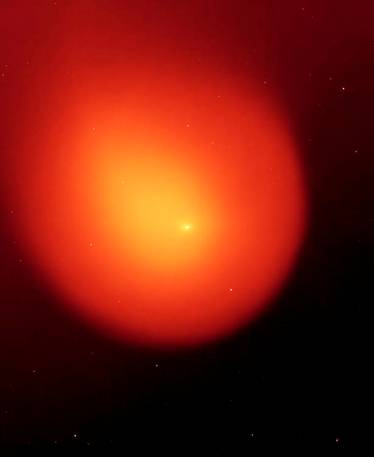15 October 2008

Credit: NASA/JPL-Caltech
When Comet Holmes abruptly erupted in 2007, professional and amateur astronomers worldwide pointed their telescopes toward the spectacular phenomenon. The enquiry was to find out why the comet had suddenly exploded.
Interestingly, observations of the flaring comet by NASA's Spitzer Space Telescope (SST) deepen the mystery, showing strange streamers in the shell of dust surrounding the nucleus of the comet. The data also offer a rare look at the material hurled from within the nucleus, and confirm previous findings from NASA's Stardust and Deep Impact spacecrafts.
"The data we got from Spitzer do not look like anything we typically see when looking at comets," said Bill Reach of NASA's Spitzer Science Center at the California Institute of Technology, Caltech. Reach is principal investigator of the SST observations. "The Comet Holmes explosion gave us a rare glimpse at the inside of a comet nucleus." The findings were presented at the 40th meeting of the Division of Planetary Sciences in Ithaca, New York.
Comet 17P/Holmes orbits the Sun every 6.9 years. Its distance from the Sun ranges from approximately 780 million km to 300 million km. The comet often completes its orbit uneventfully. However, twice in the last 116 years, in November 1892 and October 2007, Comet Holmes burst as it approached the asteroid belt, and its brightness increased a million times overnight.
In an attempt to understand these odd incidences, astronomers slewed SST to the comet in November 2007 and March 2008. By applying Spitzer's infrared spectrograph instrument, Reach was able to obtain valuable insights into the makeup of Comet Holmes' interior. Like a prism spreading visual light into a spectrum, the spectrograph breaks up infrared light from the comet into its constituents, revealing the presence of various chemicals, through characteristic spectral lines.
In November of 2007, Reach observed a lot of fine silicate dust, or crystallized grains smaller than sand, like crushed gems. He noted that this particular observation revealed materials similar to those seen around other active comets, including NASA's Deep Impact mission, which fired a projectile into Comet Tempel 1; NASA's Stardust spacecraft, which directly sampled particles from Comet Wild 2, and the outburst of Comet Hale-Bopp in 1995.
"Comet dust is very sensitive, meaning that the grains are very easily destroyed,” said Reach. “We think the fine silicates are produced in these violent events by the destruction of larger particles originating inside the comet nucleus."
When SST observed the same portion of Comet Holmes again in March 2008, the fine-grained silicate dust was gone and only larger particles were present. "The March observation tells us that there is a very small window for studying composition of comet dust after a violent event like Comet Holmes' outburst," said Reach.
Comet Holmes is an extraordinary comet that has unusual composition of dust. According to Jeremie Vaubaillon, a colleague of Reach's at Caltech, ground-based observations, performed shortly after the outburst, revealed streamers in the envelope of dust surrounding the comet. Scientists speculate they were produced after the explosion by fragments blasted from the comet's nucleus.
In November 2007, the streamers pointed away from the Sun, which seemed natural because scientists thought that radiation from the Sun was pushing these fragments straight back. However, when SST imaged the same streamers in March 2008, they were surprised to find them still pointing in the same direction, even though the comet had moved and sunlight was coming from a different direction. "We have never seen anything like this in a comet before. The extended shape still needs to be fully understood," said Vaubaillon.
He notes that the shell surrounding the comet shows a peculiar behavior. The shape of the shell did not change as expected from November 2007 to March 2008. Vaubaillon said this is because the dust grains observed in March 2008 are relatively large, approximately one millimeter in size, and thus harder to move.
"If the shell was comprised of smaller dust grains, it would have changed as the orientation of the Sun changes with time," said Vaubaillon. "This Spitzer image is very unique. No other telescope has seen Comet Holmes in this much detail, five months after the explosion."
"Like people, all comets are a little different. We've been studying comets for hundreds of years -- 116 years in the case of comet Holmes -- but still do not really understand them," said Reach. "However, with the Spitzer observations and data from other telescopes, we are getting closer."
Further Reading
SST Press Release
http://www.spitzer.caltech.edu/Media/releases/ssc2008-18/release.shtml
Hubble Zooms In on Heart of Mystery Comet
http://hubblesite.org/newscenter/archive/releases/2007/40/image/a/
A Million Comet Pieces
http://gallery.spitzer.caltech.edu/Imagegallery/image.php?image_name=ssc2006-13a
Jupiter-Family Comets
http://gallery.spitzer.caltech.edu/Imagegallery/image.php?image_name=sig05-008
Aymen Mohamed Ibrahem
Senior Astronomy Specialist